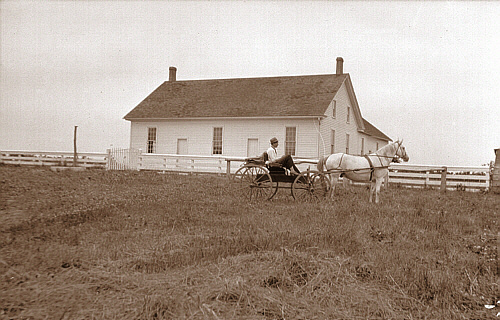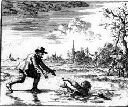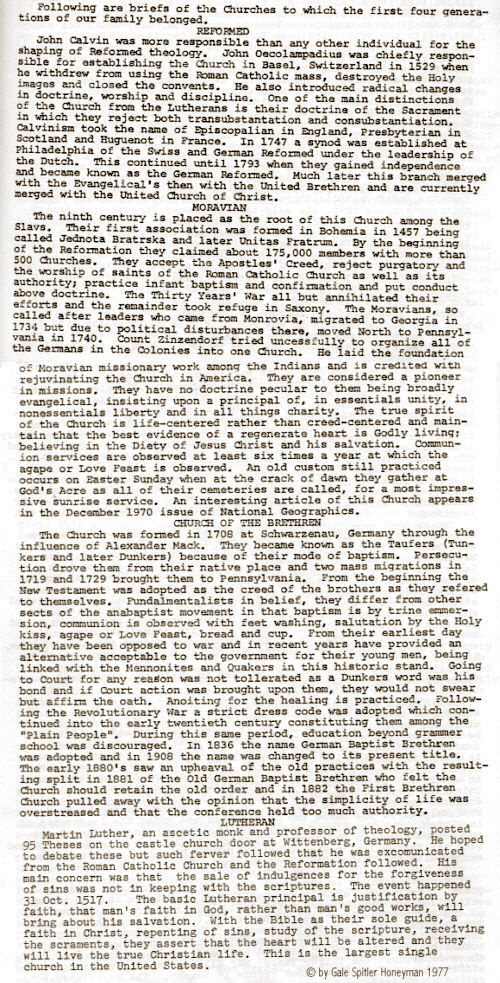
The Wisslers' / Whistlers' / Whislers' Religious Beliefs
(Edited from both Gale Edwin Spitler Honeyman's book and J.D. Weaver's Study)

Dunkard Church
(Tunkers, Taufers, Swiss Baptists, German Baptists Brethren, Church of the Brethren)
The Wisslers of Switzerland
were Anabatists who were arrested and persecuted for their beliefs until they fled to Holland and thence to America. Hans Wissler and his sister Catharina were arrested 3 times in 1610 - 1611.

The print of a copper engraving by Jan Luyken(1649-1712) appears above. This and103 other sketches by Luyken appeared in Martyr's Mirror. This sketch is a scene depicting Dirck Willems as he turns around to save his pursuer's life. He was then captured, imprisoned, and burned at the stake outside Asperen in AD 1669
The Anabaptists in Switzerland
The Anabaptist movement began before the Protestant Reformation, but is generally dated as beginning in 1525 in Zurich, Switzerland. These people felt that the Reformation had not gone far enough, and defied Zwingli's state church in Zurich. They were rebaptized as adults (this is sometimes called Believers Baptism). By this act they violated civil law as well as the law of the reformed Church. Many were martyred, including an ancestor of mine named Hans Landis who was beheaded. Many were executed by drowning, some by burning at the stake, and some by more humane methods such as beheading. Many of these executions (more than 2000) are documented in a book called the Martyr's Mirror written by Thieleman J. van Braght in 1660.
(A copy of the Martyr's Mirror was among the family heirlooms in the Spitler family. Der Blutige Schau-Platz Oder Martyrer Spiegel, printed 1747 by the Ephrata Cloister, Ephrata, Penna. Written by John Foxe 1516-1587, commonly called the Martyr's Mirror. This was the largest book printed in the colonies, with over 1,500 pages. Each volume required four hundred gallons of ink, which was composed of flaxseed oil, chimney soot, oak galls and pokeberries. Its bound under wooden covers with brass corners and clasps. No inscriptions, brought from Virginia to Ohio by John Spitler, passed on to his daughter Hannah, acquired from her estate by Miss Maude Dillan Spitler who placed it in the collection of the Bonebrake Theological Seminary, Dayton, Ohio.)
The Anabaptists in Switzerland called themselves the Swiss Brethren and later migrated into the Alsace, and the Palatinate in Germany and eventually on to Holland. We have to understand that Switzerland and Germany were divided into Cantons and Principalities. As a result of the Thirty Years War, the decision was made to let the Prince of each state determine the religion of that state. They were all either Catholic, Lutheran, or Reformed. All in that state had to follow the religion of the Prince. Many states did not tolerate the Anabaptists at all, whereas some were reasonably tolerant of them. Many found refuge for a time in the Palatinate in Germany. When things got too tough there, they moved to Holland and eventually in the early 18th century to America. They first settled at Germantown in Philadelphia and many moved on to areas west of Philadelphia, in particular a large number settled permanently in Lancaster County.
There was a splinter group who tried to set up a Theocracy in Muenster. This failed and after a long siege by the Protestant Prince, the leaders were tortured and killed and their bodies were hung on the steeple of the church in cages. These cages are still hanging there.
During the latter part of the 17th century and the early part of the 18th century, there arose a movement in Germany called Radical Pietism. They dabbled in Mysticism and more Spiritualistic practices than the Reformed or even the Mennonites. A small group of these people led by Alexander Mack formed a church in Schwarzenau, Germany in 1708. They baptized each other in the Eder River. It was never revealed who baptized Alexander Mack. There were nine men and women who formed that first group. They later became known as the Deutch Taufer or German Baptists and later the German Baptist Brethren. In the early part of this century, they became known as the Church of the Brethren.
The Brethren came to America in the early part of the 18th century and settled first at Germantown and later moved west to Schuylkill and Lancaster Counties. During the 19th century, they migrated South to Virginia and the Carolinas where many of them became involved with Universalism. They also moved West and now live in most of the 50 states. They number about 120,000 in this country with many more in Nigeria, which was their main mission field for many years.
The Brethren are one of the 3 Historic Peace Churches along with the Quakers and the Mennonites that hold Pacifism to be one of their main tenets.
(the above material is largely the work of J.D. Weaver)
Gale Spitler Honeyman wrote a fantastic geneology of the Spitler family that covers the Whistler/Whisler Line in much detail. I am indebted to her gift of this book to our family for many insights into our lineage. Below is a description of the main religious faiths that guided these ancestors in their struggle to put us where we are now, directly from her book, "The House of Spittler-Spitler".
